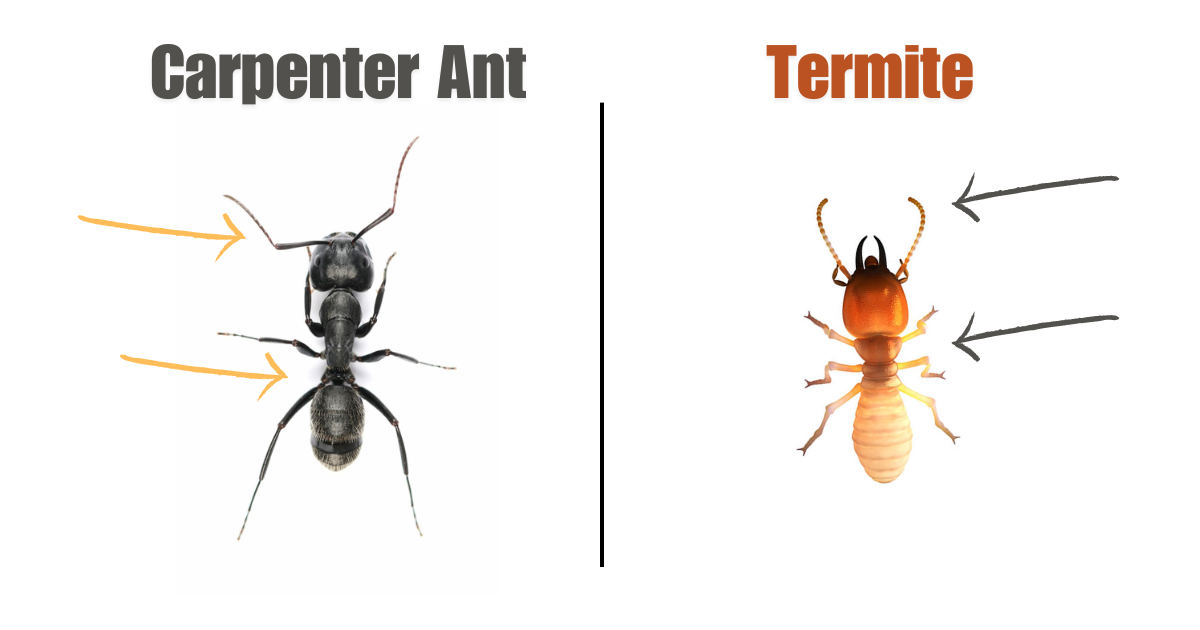Carpenter Ants vs Termites
What You Need To Know About Carpenter Ants vs Termites
If you’re looking for the main differences between carpenter ants vs termites, we have a lot to show you here. Many people get confused by the two because they have some similarities, but there’s also important differences in how they look, how they act, and how to eliminate them if you have an infestation. If you’re struggling with the difference, don’t hesitate to contact a professional pest control expert to help. You don’t want to allow the infestation to grow because it could cause significant damage to your property. Let’s dive in and see the main differences.
Size, Shape and Color Variations of Carpenter Ants Versus Termites
Beyond obvious six-legged anatomy the two insects share, what exactly differentiates carpenter ants (with more than over 4000 subspecies) from equally prolific termite swarms (nearing 4000 classified types)?
Plenty actually! These are the easiest to see and understand in the difference in appearance between the carpenter ant and the termite:

- Waist and Size Difference – Almost instantly, you’ll notice ants have extremely narrow waists between upper and lower bodies while termites have a more uniform body width throughout. Carpenter ants have 3 distinct sections in their body whereas termites have 2.
- Antennae – Carpenter ants have elbowed antennae that angle outwards (away from the head) before pointing forward. However, termites sport simple straight uniform bead-like antennae lacking angles but drifting downward toward the ground.
- Wing Symmetry Gaps – Some carpenter ants and termites have wings, but many do not. If they have wings, Carpenter ants have 2 wings on each side that will have a noticeable size difference – the front wing is larger than the hindwing. Termites however have a uniform pair of wings on each side (4 wings total).
- Color Variations Across Species - Ant bodies usually have dark black, brown or occasionally red hues across breeds. Termites tend to have translucent or diluted cream patterns ranging from opaque dark chocolate to outright milky white. This can vary between hierarchies dependent on termite roles and growth stages dictating pigmentation manifestation between either species interestingly.
While carpenter ants and termites share some common attributes (like their 6-legged body), there’s a lot that differs. The waist, the antennae and color are obvious differences. Some even have wings and those also differ between the two insects.
Behavior Differences Between Carpenter Ants & Termites
One surprising difference between termites and carpenter ants is how they each handle wood. This is where many homeowners get these insects confused, because both insects enjoy being around wood. However, they treat wood differently.
Termites actually eat and consume the wood they nest in. This is why people commonly refer to termites as a “more devastating” problem than an ant infestation. If left unchecked, termites could chew threw and eat nearly all the support beams in a house and leave it teetering on destruction. If you’re seeing signs in your floor or ceiling that look like water damage (but you see no signs of water), this could be a sign of termites. As they chew and eat the support beams, floors begin to sag and this is often mistaken for water damage.
Carpenter ants are different. They eat some of the wood, but it’s mostly for nesting and burrowing and not as a food source. These ants are still attracted to human food which is why you might see them sneaking around your kitchen pantry at night. The wood is just a safe harbor for the carpenter ants to live. It can cause slight damage to a structure, but far less than what termites do.
Detecting and finding these two insects is not the same either. Carpenter ants tend to be easier to locate because they will venture away from the nest in search of food. During their journey, the ants sometimes leave small piles of excrement called frass which can be found. Termites, however, rarely venture away from the nest so they can go undetected for long periods of time. Combine that with their insatiable hunger for wood and you can see why they’re more dangerous for homeowners long term and must be eradicated quickly.

Infestation Differences
How do you know if you have an infestation of carpenter ants or termites? Well, here are a few key differences to look for. Remember, contact a
professional pest control expert if you’re unsure. Neither pest is one to mess around with and let their colony grow inside your house.
- Sawdust and Frass: Finely granulated pre-digestion byproducts resembling sawdust (named frass) spewed from carpenter ant colonies burrowing new chambers. This frass can sometimes be found around the exit points of their nest. Termites interestingly leave no leftover wood shavings waste since it’s their food and consumed constantly by workers.
- Mud Tunnels: Termites creates hardened earthen corridors leading to subterranean kingdoms as they search for large sections of wood. These well-built highways help termites travel efficiently while protecting vulnerable worker forces underground during critical aboveground food raids. Sometimes, mud pipes traces can be found on exterior foundations of a home as the termites attempt to find the wood in your house.
- Wood Damage Traces: Termites consume wood completely making it easy to tell when they have arrived. Carpenter ants often just burrow into the wood making unique tunnels and caverns inside the wood structure. If you find wood pieces that have holes scattered throughout, that’s likely a sign of ants and not termites.
Handling Carpenter Ants and Termites
We highly recommend contacting a pest control service to help with termites and carpenter ant infestations. Termites can cause significant damage to the structure of your property, so the longer you wait the more damage that could come with it. Termites are notoriously known in the remodeling industry as a “schedule killer” because they delay everything significantly.
Carpenter ants can be a nuisance but often less damaging to property. However, infestations can cause larger problems if left unchecked because the colony will grow and could bring health challenges to your family. Don’t let these invaders harm your family. If you live in Redmond, WA, contact our team today and let’s help eliminate these problems! Also check out the detailed FAQ guide on pest control here to learn more about common household pests.
Other Pest Articles You Might Enjoy
Does Construction Cause Pests To Be More Active?
Why Do I Suddenly Have Large Flies In My House?
The Best Natural Deterrents For Ants
What NOT To Do After Pest Control Service Spray?
The Top 5 Most Common Questions About Pest Control
Pest Control Service vs an Exterminator - What's The Difference?
Can Pest Control Get Rid of Roaches?
Can Pest Control Get Rid of Fleas?
